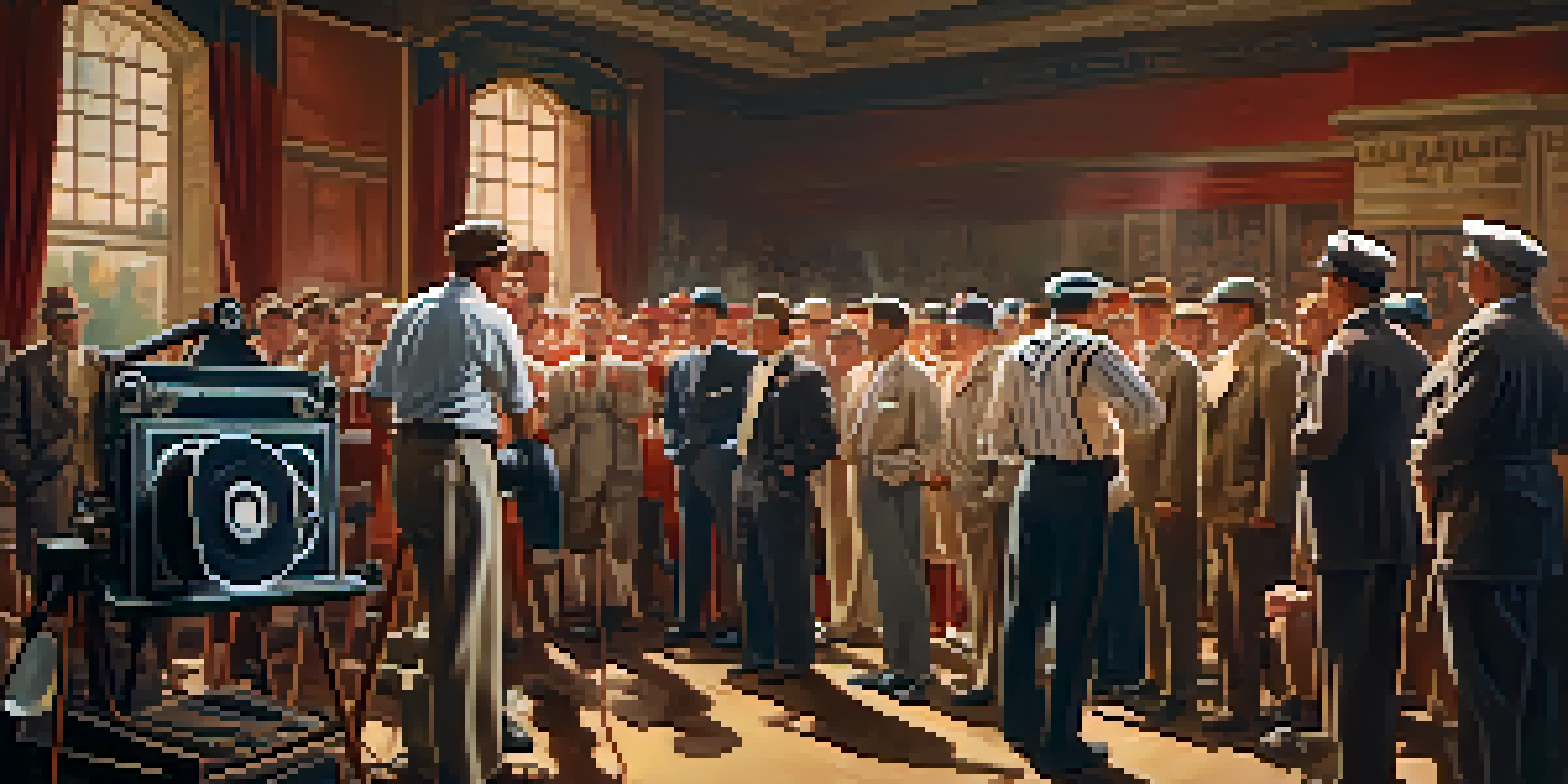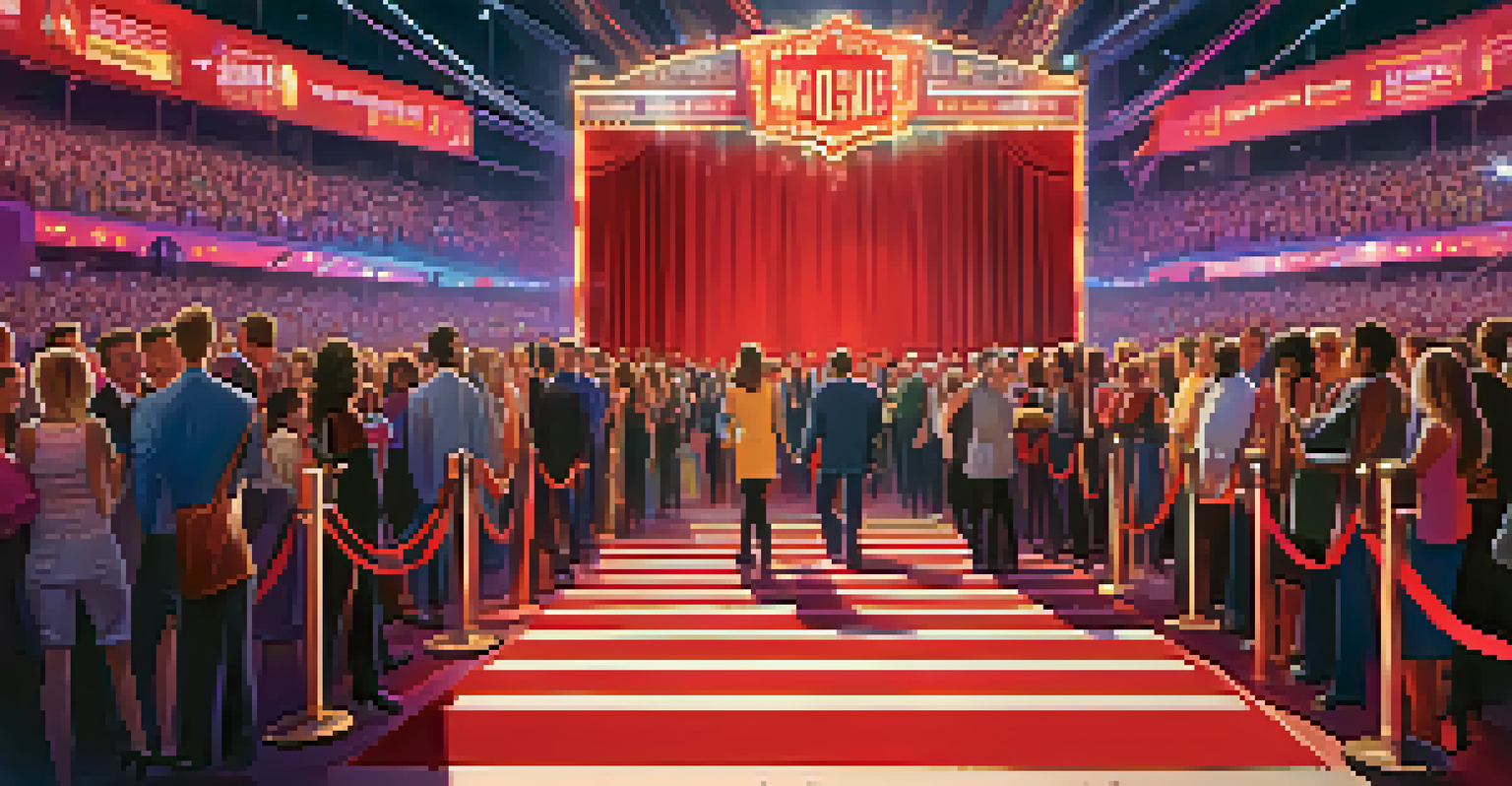The Evolution of Sports Representation in Hollywood Movies

The Birth of Sports Films: Early 20th Century Beginnings
The journey of sports representation in Hollywood began in the early 1900s with silent films. These early movies often showcased sporting events and athletes, but they lacked the narrative depth we see today. For instance, films like 'The Great Train Robbery' featured a brief boxing scene, hinting at growing public interest in sports.
Sports do not build character. They reveal it.
As the film industry evolved, so too did the portrayal of sports. By the 1920s, more narrative-driven films emerged, focusing on the lives of athletes and the challenges they faced. This shift not only entertained audiences but also inspired many to engage in sports themselves.
Films during this period laid the groundwork for future sports dramas. They highlighted the passion and dedication athletes possess, setting the stage for more complex stories that would come in the following decades.
The Golden Age of Sports Movies: 1930s to 1950s
The 1930s to the 1950s marked a golden age for sports films, with classics like 'The Champ' and 'Pride of the Yankees'. These films not only focused on the sport itself but also on the personal struggles of the athletes, making their stories relatable to audiences. The emotional depth captured in these films resonated with viewers, creating lasting legacies.

During this era, Hollywood began to recognize sports as a metaphor for broader life experiences. Athletes' journeys were portrayed as universal struggles, reflecting themes like perseverance, triumph, and redemption. This allowed audiences to connect with characters on a deeper level.
Evolution of Sports Films
Sports films have transformed from simple portrayals of athletic events to complex narratives that explore the personal and societal challenges faced by athletes.
Moreover, the rise of television brought sports into the living rooms of millions, further increasing the popularity of sports-themed films. The fusion of sports and cinema became a cultural phenomenon, shaping how society viewed both realms.
The Rise of Biopics: 1960s to 1980s
The 1960s to 1980s saw a significant rise in sports biopics, showcasing the lives of legendary athletes. Films like 'Rocky' and 'Raging Bull' depicted not only the physical challenges but also the mental battles faced by these sports icons. These narratives brought authenticity to the genre, engaging audiences with real-life stories.
The only way to prove that you’re a good sport is to lose.
Biopics allowed filmmakers to explore the complexities of sports figures, often highlighting their struggles off the field. This deeper exploration helped to humanize these athletes, showcasing their vulnerabilities alongside their achievements. It also provided a platform for discussing broader social issues, such as race and class.
As a result, sports biopics became a staple in Hollywood, appealing to both sports fans and those unfamiliar with the athletes. This trend emphasized the idea that sports are not just games, but also powerful narratives that reflect society.
Changing Narratives: 1990s to 2000s
In the 1990s and 2000s, sports films began to diversify, incorporating various genres and styles. Comedies like 'Happy Gilmore' and 'The Waterboy' brought humor into the sports narrative, attracting a wider audience. These films often showcased the lighter side of sports, balancing the intense dramas of previous decades.
During this time, we also saw an increase in films that challenged traditional sports narratives. Movies like 'Remember the Titans' tackled important social issues, using sports as a backdrop for discussions on race and teamwork. This shift indicated a growing awareness among filmmakers of the power sports have to drive social change.
Rise of Diverse Narratives
The representation of women in sports films has increased, highlighting their contributions and addressing issues of sexism and inequality in the sports world.
Moreover, the introduction of technology and special effects allowed filmmakers to create more dynamic sports scenes. This evolution not only enhanced visual storytelling but also drew in younger audiences who craved excitement and action.
The Role of Women in Sports Cinema: 2010s and Beyond
The 2010s marked an important shift in the representation of women in sports films. With titles like 'Hidden Figures' and 'A League of Their Own', Hollywood began to tell stories that highlighted female athletes and their contributions to sports history. This focus on women's narratives helped to inspire a new generation of female athletes.
These films often addressed the challenges women face in the sports world, including sexism and inequality. By shining a light on these issues, filmmakers encouraged conversations about gender equality, making sports representation more inclusive. The impact of these stories extends beyond the screen, influencing societal perceptions of women in sports.
As society continues to push for greater representation, it’s clear that the evolution of women’s roles in sports films is just beginning. With more stories being told, audiences can look forward to seeing the diverse experiences of female athletes.
The Impact of Technology on Sports Filmmaking
Advancements in technology have revolutionized how sports films are created and experienced. Enhanced visual effects and camera techniques allow filmmakers to capture the thrill of sports like never before. This not only makes the action more exciting but also immerses viewers in the experience, fostering a deeper emotional connection.
Moreover, the rise of streaming services has changed the landscape for sports films. Audiences now have access to a myriad of sports narratives, leading to an explosion of content that caters to diverse tastes. This shift enables filmmakers to experiment with storytelling, creating unique perspectives on familiar sports themes.
Impact of Technology
Advancements in technology have enhanced the visual storytelling of sports films and expanded access to diverse sports narratives through streaming services.
As technology continues to evolve, the possibilities for sports representation in film are boundless. Filmmakers can push creative boundaries, reflecting the dynamic nature of sports and their impact on society.
The Future of Sports Representation in Hollywood
Looking ahead, the future of sports representation in Hollywood appears promising. As audiences demand more authentic and diverse stories, filmmakers are likely to continue breaking traditional molds. This shift opens doors for underrepresented voices in the sports world, enriching the narratives told on screen.
Additionally, the integration of virtual reality and augmented reality could transform how sports stories are experienced. These technologies may allow viewers to engage with the narrative in a more interactive way, bringing them closer to the action and the athletes’ journeys.

Ultimately, the evolution of sports representation in Hollywood reflects broader societal changes. As long as sports continue to inspire and unite people, filmmakers will find ways to tell compelling stories that resonate with audiences across generations.